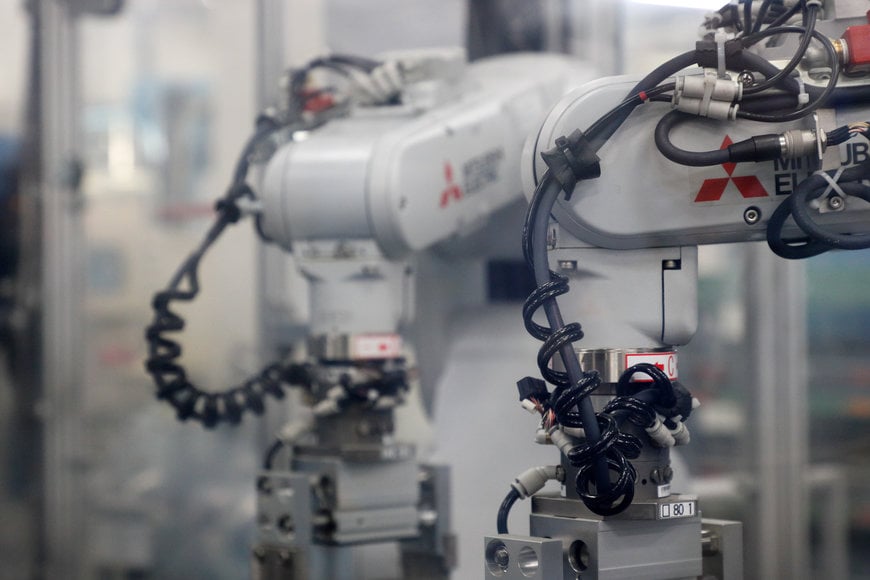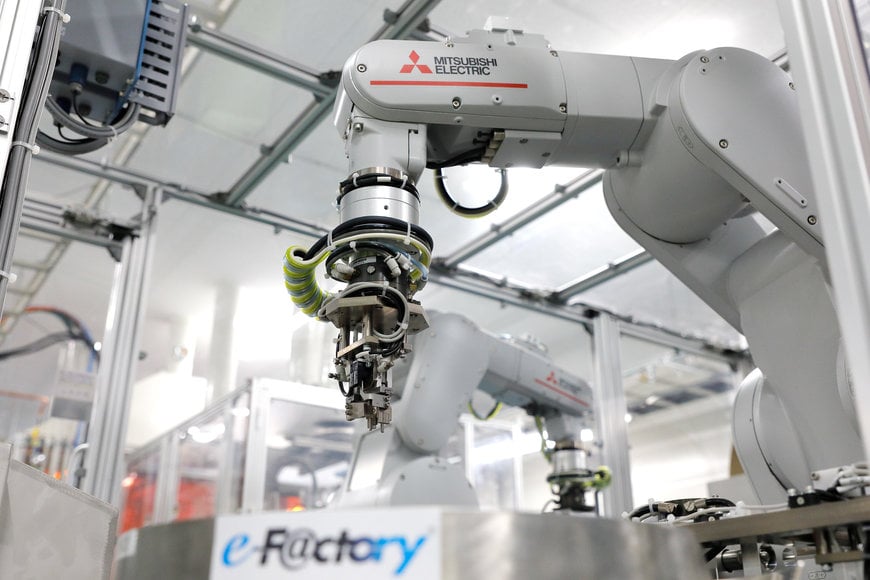www.magazine-industry-usa.com
06
'21
Written on Modified on
Robots will become smarter, more connected, and more mobile
An interview of Chris Hazlewood, Chief Editor, Factory Automation Promotion Group, Mitsubishi Electric. By Milton D’Silva.

Mitsubishi Electric has proven expertise in robotic solutions. What are the factors contributing to the growing popularity of robots?
There are a lot of things all converging at the same time to create a ‘perfect wind’ for the growing acceptance of robotics. It starts with the internet age and netizens wanting more product choice and shorter delivery periods. This drives the need for faster response from manufacturers but also the need to ensure there are no lapses in quality, and robots are a natural choice to solve both points. In parallel, there has been a major expansion of potential robot applications. No longer are robots restricted to an isolated cell to perform high speed processes, robots and humans are now working side by side. This has been made possible because many of the understandable human safety issues are resolved through new collaborative robot concepts, the use of AI vision systems to make adaptive path decisions and protective solutions like ‘soft skins’ around the robots – all of these innovations reduce the fear factors, increase the usability and speed up the adoption. And finally, there is the realisation in many countries that there are concerns about the future available workforce as the population ages and skills are potentially lost, so again robots are a natural solution to this.
How will the rise of Electric Vehicles impact use of robots in automotive industry, which is one of the largest users?
When you think of the automotive industry and robotic use you probably imagine big robots lifting and welding panels or applying the painting processes that give the car its impressive finish. Actually, robots are used on multiple other areas from haptic testing of the drivers’ console, through to assembly of multiple subcomponents and electronics. In our showroom in Akihabara, Tokyo we even demonstrate the assembly of the in-car entertainment system, by robots. Furthermore, I saw recently a very innovative use of robots to change car tyres in a shorter time and with recordable security that each wheel, nut and tyre have been correctly installed. The reason I relate these examples is each of these applications will still remain regardless if it will be a fossil fuel engine or an EV. In addition, I also think these examples illustrate just how innovative automotive manufacturers are at utilising automation to gain production flexibility and advantage. It’s a trend I don’t see changing and if anything, accelerating as robots may gain new tasks in the building of electrical motors, installation of battery systems, etc.
BTW if you want to see that wheel changing application take a look at this video
Are Cobots with their greater appeal bridging the gap with conventional robots on assembly lines?
Collaborative robots are definitely a great addition to the robotic portfolio, and yes in some cases they bridge an existing gap but more frequently they open-up a totally new field of application. To be honest this is one of the most exciting things about collaborative robots in the way they are challenging the way we think about how we do things.
However, I think it’s important to understand that actually there are a lot of different robot types, from traditional single arm-multi axis, to multi arm, delta (or sometimes called spider) robots, twin beam high speed placement robots, etc. The key thing to remember here is each robot type has a specific strength, so at one end of the scale you have high speed, ultra precise robots operating with no human intervention, maybe in the middle you have high IP rated robots that are working in environments that may be unfriendly to humans, and at the other end you have collaborative robots which are working very closely with people and consequently will be slower and more typically a little less precise. But there is no doubt, collaborative robots are expanding an already extensive solution portfolio.
Use of robots in the service industry is rising – what does this mean for the leading vendors?
Service robots are definitely ‘on the rise’. In China recently we saw a restaurant taking orders by mobile phone/2D code, creating/cooking and delivering the dish to the customer – all by various different types of robots. Amazing! In Japan there are robots delivering luggage or small amenities to guests in hotel rooms, so there are a lot of people coming up with a lot of imaginative ways to utilize technology. Will that trend continue? Absolutely!
But moving back to the manufacturing environment, there are equally interesting developments there from very innovative, high density warehouse storage solutions managed by service robots to traditional AGV type parts delivery. What really is exciting is the combination of a traditional robot with an AGV to create the potential of a self-configuring production environment, bringing ‘work-stations’ in different orders and configurations by redeploying them at will. For sure the robotic hardware is critical, but then so is the battery systems for such mobile applications. Added to that the use of safety systems to protect workers and vision and AI to manage programless task configuration, now you can understand the answer I gave earlier that there is this “perfect wind” propelling the adoption of robotics, and honestly we are just at the start of it.
How has the Covid-19 pandemic affected the industrial robots market?
The whole Covid situation is a challenge to us all both on a humanitarian front and on a business and manufacturing front. However, the human spirit is very resilient, and a lot of people have used this regrettable situation to try to find new ways to do things. Social distancing as applied to manufacturing is even more challenging. Often this has meant that factories have implemented a multiple shift system to reduce the number of workers present at any one time. But sometimes that’s simply not feasible because you need a certain level of operational resource to make the manufacturing process work. In those case for sure the use of PPE for workers is absolute, and the simple addition of screens and barriers are also a big help. But still this does not solve all problems and as a consequence we have seen a real surge in interest in collaborative robots. Typically, these enquiries are applications to support a worker where, potentially in the past there were two workers side by side, but now due to the shift rotation only one is present at any one time. So yes, there has been an increase in interest in robotic solutions, but in addition remote maintenance and predictive maintenance solutions are also garnering renewed interest.

There has been a major expansion of potential robot applications. Image Source: Mitsubishi Electric
Will the growing use of AI and ML provide the much needed boost for wider use of robots in industry?
Yes, indeed AI and ML are already making their impact felt. However, for most people AI and ML are in some way indivisible. As customers they are primarily interested in what it delivers as a benefit to them not necessarily how it does it, that’s probably more interesting for the engineers!
To try to illustrate how important this is, let me give you a few examples, because to simply say ‘AI empowered vision solutions’ do not do justice to the wide range of what that can entail. From applications around vision to support auto path generation avoiding obstacles and people, to innovations of picking and sorting objects in bins or even selecting and handling natural, delicate items like plant cuttings at a farm where each cutting is basically unique, AI is enabling robots to add more value across a wider range of tasks. But that’s again not the whole story. AI is also allowing us to control robotic grippers in more advanced ways than ever before. Imagine picking up a ‘bag’ of washing detergent, as the robot lifts it, two very difficult things happen that needs controlling. As the bag is raised the contained detergent displaces, this changes the centre of gravity of the bag but at the same time can also change the ‘shape’ of the bag as the detergent collects at the bottom…and the robot and its gripper have to react in milliseconds to prevent the bag from being dropped and potentially damaged. I could go on about AI enabled maintenance or the benefits of AI being used to potentially control a robot by voice or hand gestures, there is so much happening right now it is fantastic.

Integration of machines with robotics presents a unique opportunity. Image Source: Mitsubishi Electric
What are the future trends for robots at Mitsubishi Electric?
Robots will become smarter, more connected, more mobile and more ‘normal’. They will become an ever increasingly familiar sight not only in manufacturing but in our everyday life, from shelf management in the supermarket, to hotel concierge functions and even serving your coffee. Many of these activities are being pioneered now but will mature and become more widespread in the world of tomorrow. AI and ML will not be something unusual or to be feared, but a background function that enables and supports. Customers will not be looking to buy an AI enabled device but to buy a smart device to fulfil specific tasks; Window cleaning, vacuuming the floor, testing a product, assembling parts…walking the dog?!
Will robots become humanoid in appearance and operation? That’s more of a question for society in general, but as is the current case there will not be one ‘type’ of robot but a multitude, some for general tasks, others for dedicated tasks.
How will we interact with robots? Well we talk with our smart home assistant to find out the weather, play our favourite music, etc…so why should we not talk with the robots of the future to do tasks or report status? Whatever the future holds for us it is sure to be both exciting and very different than what we can imagine today – and probably a little more mundane. Interestingly, the Japanese Government has a project called ‘Society 5.0’ which seeks to understand the balance and fit of technology, business, people and society in general as we grapple with the 4th industrial revolution, aging populations, increasing environmental pressures and dwindling resources. Following that concept may just give us all a glimpse of what the future may truly hold and we as Mitsubishi Electric will be there to support both our customers and to help support and improve society as we ‘change for the better’.
www.mitsubishielectric.com

